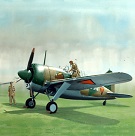wdolson
Posts: 10398
Joined: 6/28/2006
From: Near Portland, OR
Status: offline

|
quote:
ORIGINAL: geofflambert
The tail surface area on the Spit is generally less, the wings are broader front to back at the fuselage, the engine compartment is proportionately larger and the Spit usually has a four bladed prop and the Hurri three. In theory the most efficient number of blades would be one if you could balance it somehow. Since you're somewhat limited in the length of the blades (it's not good if they hit the ground) you have to add blades to take full advantage of greater engine power. Just looking at the Spit's wings you know it's going to be a kite, sort of like the difference between a Fokker Dr-1 and a Camel. edit: I meant a Sopwith Camel, not the four legged kind the Arabs fly.
Reg, why the Packard engines? Was it because the P-51's were sucking up all the Merlin's? That's something way over my head (not that that's saying much) but the difference between a P-51 with a Packard and a P-51 with a Merlin is huge, not so much for a Spit I suppose.
The Spitfire didn't get 4 bladed props until the Mk VIII. Rolls Royce continued to build Merlins in the UK, but Packard in the US built them under license. The deal to build Merlins under license was actually struck before the P-51 got the Merlin. The Packard Merlins were going to Canadian built Hurricanes and P-40Fs. In 1944 the British were building Spitfires faster than Rolls could build Merlins, so some Mk IX airframes were built with Packard Merlins instead. I believe they were the Mk XIV (it was a mark around that number).
Except for a few testbed P-51s, all P-51s had Packard built Merlins. According to Bill Dunn who was in the Eagle Squadrons and later flew P-47s in the USAAF as well as P-51s, the performance of the Packard and Rolls Royce Merlins were pretty much the same, but the Rolls built Merlins were hand built and ran much smoother than the Packard built engines which were mass produced.
The Spitfire was one of the easiest WW II fighters to land. Because of the wing shape, it tended to float when descending and had very gentle stall characteristics. Many of the better fighters had very brutal stall characteristics. The Fw-190 went from flying to a brick without warning. The Corsair had a tendency for one wing to stall before the other. The P-51 needed constant attention on the controls or it would be all over the sky. The only other top fighter that had very good low speed characteristics was the F6F, which was one reason the USN stuck with it. The P-40 was very gentle at low speeds too, but it was considered mostly obsolescent as a first tier fighter by 1943.
_____________________________
WitP AE - Test team lead, programmer  |
 Printable Version
Printable Version













 Thanks for posting. Wish I could have been there.
Thanks for posting. Wish I could have been there.
 New Messages
New Messages No New Messages
No New Messages Hot Topic w/ New Messages
Hot Topic w/ New Messages Hot Topic w/o New Messages
Hot Topic w/o New Messages Locked w/ New Messages
Locked w/ New Messages Locked w/o New Messages
Locked w/o New Messages Post New Thread
Post New Thread